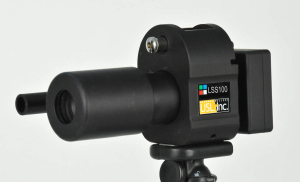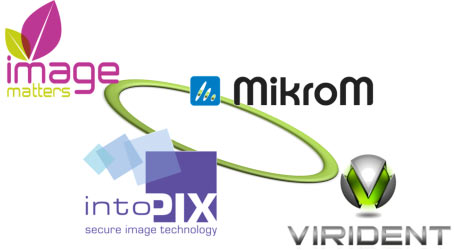As the Image Matters press release indicates, the concept of High Frame Rate for Digital Cinema being 48 or 60 is so 2011. The new I’m XS video board calls out at 120 fps and beyond. We’re not certain when “and beyond…” became a technical term, but it is better than ‘greater than…”
What we know is that 48 is going to be a bridging technology at best. The presentation from the Jackson/Park/Hobbit team at SMPTE/NAB earlier this year mentioned that they had to predict the future with insight (and a strong bet) into how many manufacturers could get to 48. They figured correctly that 48 would be possible, and tests seem to indicate that cinema theaters who want to go that route will have equipment that works.
It seems that Image Matters idea is that the time for arbitrarily picking numbers based on odd circumstance is over. 24 frames per second was chosen for reasons of what passed for sound fidelity many many decades ago. Multiplying anachronism by hyperbole might work…but why let it?
IBC also might be blessed with two competing sound systems in the auditorium. What we know is that the Prometheus showing on Saturday will be with Dolby 3D and Dolby’s new audio system, Atmos. But Auro 3D, marketed through Barco, has announced that they will also be demonstrating in the auditorium. One wonders if they will be ever playing Dualing Banjos together.
One also wonders if we can get a Big Auditorium showing of the Image Matters art and science…
More as it happens.
Image Matters Press Release — They’ll be at booth # 10.D31
(Boncelles, Belgium–September 3, 2012) At IBC 2012, Image Matters will contribute to the evolution in advanced imaging. It will announce a new system for evaluating high frame rate digital cinema quality. Built around the Image Matters I’m XS video board for extreme imaging, the system will allow high frame-rate image streams of 2K 120 fps and beyond.
Delivering playback simultaneously from uncompressed and JPEG 2000 files, the system compares in real time original and encoded-decoded pictures. It displays various picture combinations like side-by-side, butterfly, and pixel-to-pixel differences.
To reach the utmost quality, the system is capable of JPEG 2000 bitrates in excess of 1Gbps — more than four times the current DCI specification. The decoded 2K images are transmitted to four 3G-SDI links to Digital Cinema qualified projector at frame rates of up to 120 fps (or 60 fps per eye for stereoscopic 3D content).
Helping to prepare the content for comparison, the system can encode in multiple JPEG 2000 encoding formats. It can handle image resolutions up to 4K using a single I’m XS board.
At the heart of the system, the I’m XS board provides the JPEG 2000 processing power for 30 frames per second at 4K, or more than 120 fps at HD or 2K, using a compression engine from intoPIX. Multiple I’m XS boards can be linked for even more demanding applications. For example, four boards can be synchronized to deliver 4K images at 120 frames per second.
“IBC is a wonderful opportunity to promote JPEG 2000 and to discuss how to even improve image quality on cinema screens” said Jean-François Nivart, CEO at Image Matters.
More information about this and any other Image Matters products is available at http://image.matters.pro or by phone at +32 495 23 00 08.
Auro-3D Press Release
Auro Technologies Demonstrates Auro-3D® Solution
Delivering True 3D Sound Experience at IBC2012
The company also presents its Auro-Codec, integrating multi-channel audio into uncompressed PCM streams and offering full compatibility with existing and future playback and distribution formats.
Amsterdam, 3 September, 2012 – At IBC2012, Auro Technologies, a spin-off of the renowned Galaxy Studios, is demonstrating its groundbreaking Auro-3D® audio format, combining an unprecedented immersive sound experience with revolutionarytechnology based on uncompressed audio quality and full compatibility with existing standards and formats. Also during IBC2012, the company is showcasing its new Auro-Codec solution to support the new format and release its full potential. Both solutions offer unrivalled ease of use and new levels of cost-efficiency (bandwidth reduction up till factor 8 without audible loss), and will help bring richer forms of audio entertainment to the market. The Auro-Codec is very attractive for the Auro-3D® format, as well as for Surround and Stereo.
The next-generation 3D theatre sound system, Auro-3D® is the only solution offering a true 3D immersive experience, based on a newly developed recording and production process and a unique loudspeaker placement in theatre settings. Auro-3D® adds a height layer around the audience above the traditional 2D surround sound system, creating a unique sensation of authentic life-like spatial sound. Apart from being fully compatible with existing production processes and theatre systems, it also offers a host of advantages such as Single Inventory Distribution (multiple formats are combined in one PCM carrier) and full DCI compliancy. Thanks to its seamless compatibility and supporting encoding/decoding technologies, Auro-3D® is easy to implement in existing workflows and DAW stations, offering the most cost-efficient solution to provide a truly immersive listening experience.
The patented all-in-one Auro-Codec format offers the following key benefits:
- encoding of multi-channel audio into a single PCM stream with fewer channels (e.g. 9.1 into 5.1), which can be played back by existing systems without the need for a decoder. When the decoder is used, though, the extra channels can be retrieved in their original audio quality
- decoding of the original multi-channel audio with 100% channel separation
- audible lossless compression with greater compression ratios than lossy codecs without the use of any kind of perceptual coding or masking techniques
- highest compatibility (backward and forward) with existing playback and distribution formats
New standard
Auro-3D® is the only independent and viable alternative to existing 3D sound processing solutions, exceeding the audio quality of competitive technologies. It meets the existing and future needs of a wide variety of professional and consumer markets, ranging from cinema, broadcasting and automotive to consumer electronics, multimedia and mobile devices. With its ease of use, end-to-end compatibility and affordability, Auro-3D® offers all it takes to become the next-generation standard for 3D audio reproduction.
Coming up: Beautifyer™
Coinciding with IBC2012, Auro Technologies is also launching the Beautifyer™ app, an audio player for iPhone and iPod Touch that quickly transforms your digital music library into a totally new sound experience through headphones. Beautifyer™ enhances the quality of any compressed stereo music file playable on iTunes (MP3, AC3 or AAC) by expanding its impact and depth. For more info and downloads, go to www.beautifyer.com.
Find us, hear us at IBC2012
Visit Auro Technologies at IBC2012 in the RAI Conference Centre in Amsterdam. You will find us at Stand 3.A40, in Hall 3.

